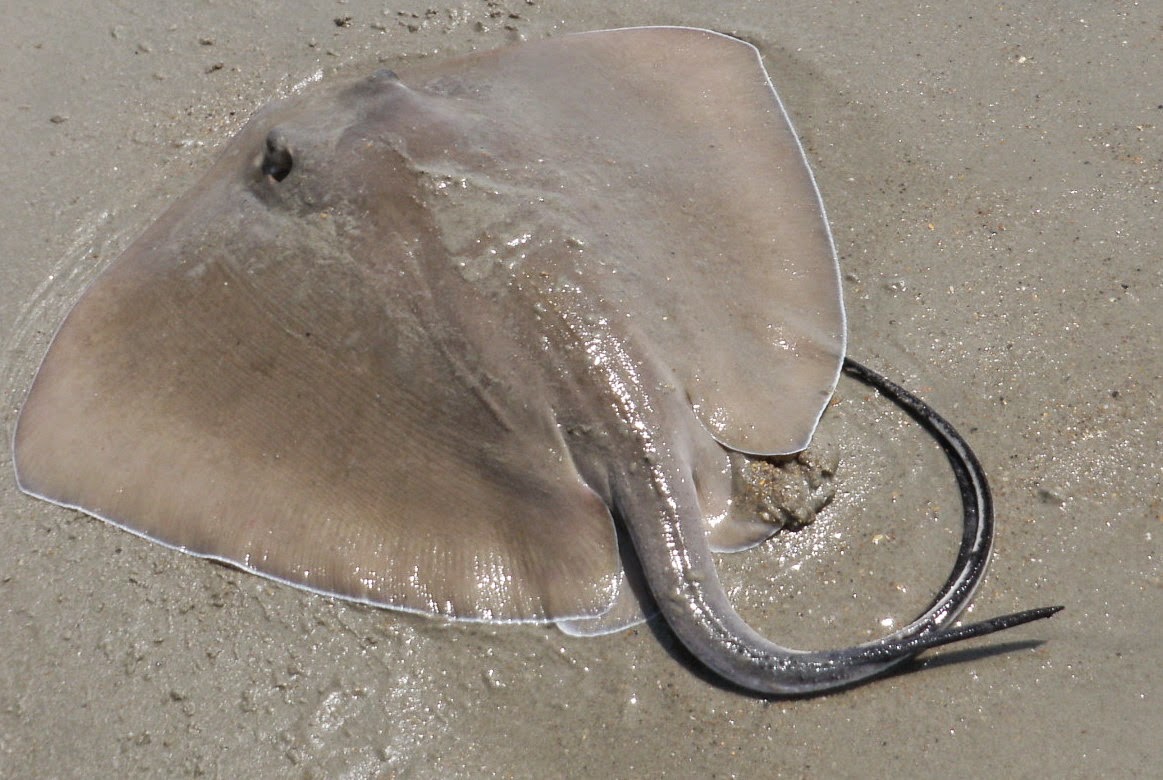What to do for stingray sting. Stingray Sting First Aid: Essential Steps for Immediate Treatment and Pain Relief
What are the immediate steps to take after a stingray sting. How can you effectively manage pain from a stingray injury. When should you seek emergency medical attention for a stingray sting. What are the potential complications of untreated stingray stings.
Understanding Stingray Stings: Causes and Symptoms
Stingrays are fascinating marine creatures, known for their flat, disk-shaped bodies and long, whip-like tails. While generally docile, these animals possess a potent defense mechanism in the form of venomous spines on their tails. Stingray stings typically occur when unsuspecting swimmers or beachgoers accidentally step on these creatures in shallow waters.
The primary symptom of a stingray sting is immediate and intense pain at the wound site. This pain can quickly spread and may reach its peak intensity within 90 minutes of the injury. Other common symptoms include:
- Swelling and discoloration around the wound
- Bleeding from a jagged wound
- Nausea and weakness
- Anxiety and sweating
- In severe cases, difficulty breathing or chest pain
Immediate First Aid for Stingray Stings
If you or someone near you experiences a stingray sting, it’s crucial to act quickly. Here are the essential first aid steps to take:
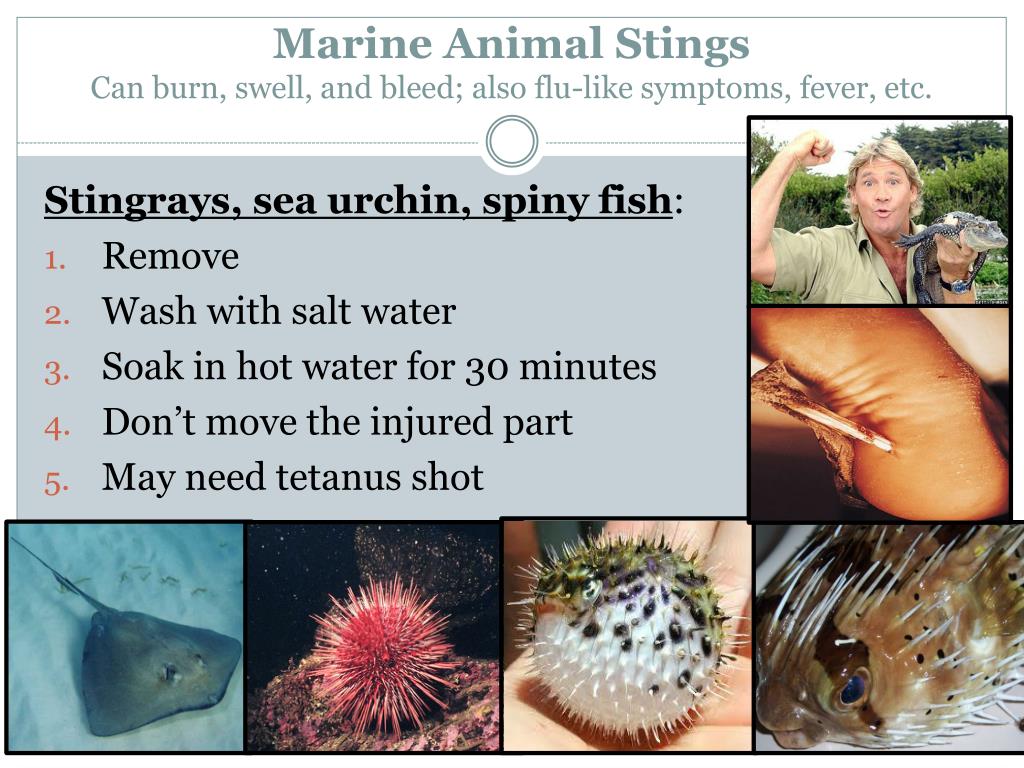
- Assess the wound location: If the sting is on an extremity and the barb is superficial, you can attempt to remove it. However, if the barb has penetrated the neck, chest, or abdomen, do not attempt removal and seek emergency medical attention immediately.
- Rinse the wound: If possible, remain in the ocean and allow the salt water to clean the wound naturally. This can help remove any remaining fragments of the stingray’s spine or sheath.
- Control bleeding: Apply firm, direct pressure to the wound to slow bleeding.
- Immerse in hot water: While not definitively proven, some experts recommend immersing the affected area in hot water (as hot as can be tolerated without scalding) for 30-90 minutes. This may help neutralize the venom and provide pain relief.
Pain Management and Further Treatment
Managing the intense pain associated with stingray stings is a critical aspect of treatment. Here are some approaches to pain relief and further care:
- Over-the-counter pain medications: Nonsteroidal anti-inflammatory drugs (NSAIDs) like ibuprofen can help reduce pain and inflammation.
- Local anesthetics: In a medical setting, healthcare providers may administer local anesthetics to numb the affected area.
- Wound care: Proper cleaning, debridement, and dressing of the wound are essential to prevent infection.
- Tetanus prophylaxis: Ensuring tetanus immunization is up to date is crucial following a stingray sting.
When to Seek Emergency Medical Attention
While many stingray stings can be managed with first aid and home care, certain situations require immediate medical attention. Seek emergency care if:

- The barb has penetrated the neck, chest, or abdomen
- There are signs of a severe allergic reaction (anaphylaxis)
- The victim experiences difficulty breathing or chest pain
- The bleeding is severe or cannot be controlled
- There are signs of infection, such as increased redness, swelling, or pus
Potential Complications and Long-Term Effects
While most stingray stings heal without significant complications, it’s important to be aware of potential issues that may arise:
- Infection: The wound site can become infected if not properly cleaned and cared for.
- Tissue necrosis: In rare cases, the venom can cause localized tissue death.
- Retained foreign bodies: Fragments of the stingray’s spine or sheath may remain in the wound, potentially causing ongoing problems if not removed.
- Chronic pain: Some individuals may experience persistent pain at the sting site for weeks or even months.
Prevention: Avoiding Stingray Encounters
The best way to deal with stingray stings is to avoid them altogether. Here are some preventive measures to consider:
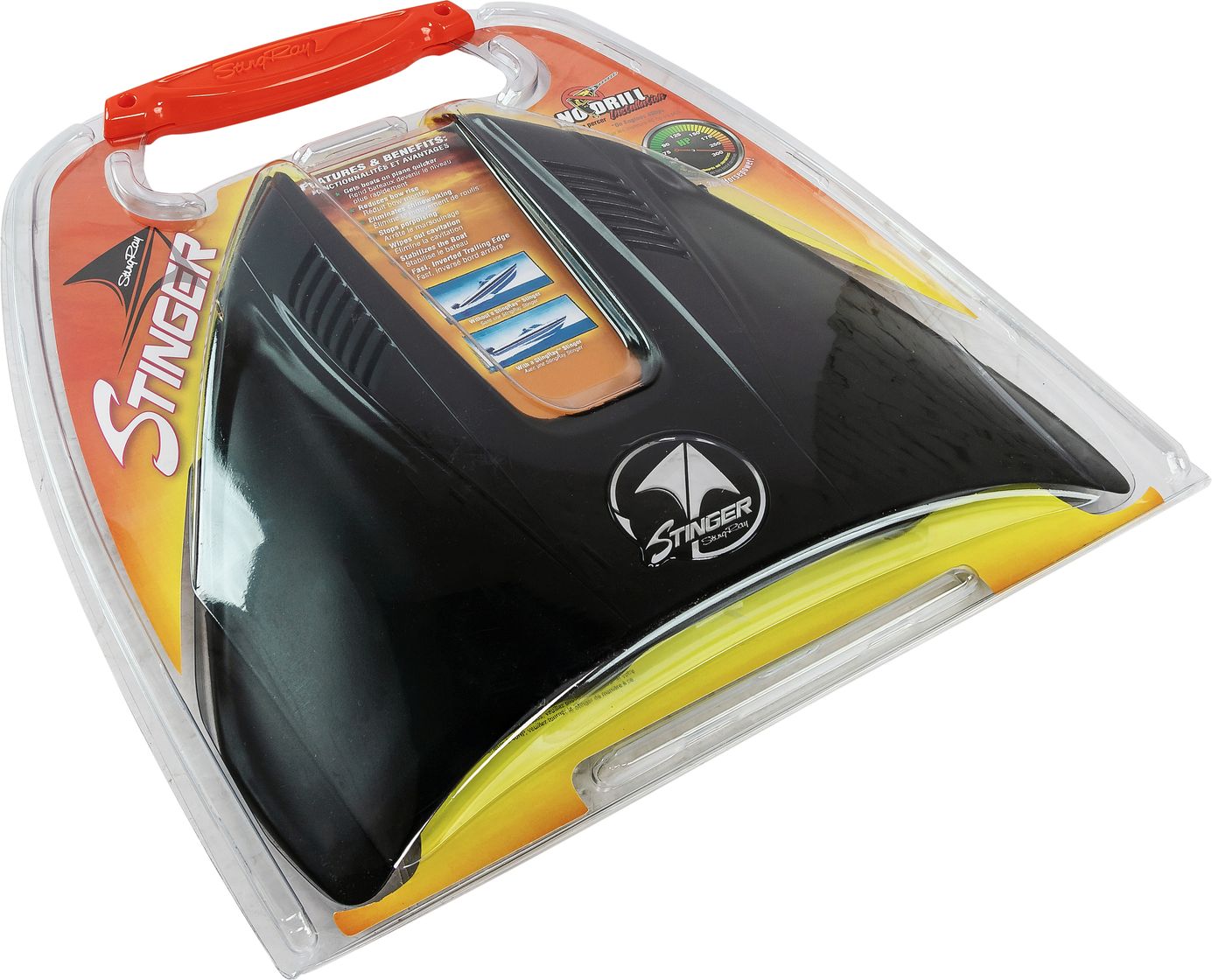
- Shuffle your feet: When walking in shallow water, use the “stingray shuffle” – sliding your feet along the bottom instead of taking steps. This alerts stingrays to your presence and gives them a chance to move away.
- Wear protective footwear: Sturdy water shoes can provide an extra layer of protection against stingray barbs.
- Be aware of your surroundings: Pay attention to warning signs on beaches and avoid areas known for high stingray populations.
- Use caution during peak seasons: Be particularly vigilant during warmer months when stingrays are more active in shallow waters.
Stingray Biology and Behavior: Understanding the Creature Behind the Sting
To better appreciate why stingrays sting and how to coexist with them safely, it’s helpful to understand more about their biology and behavior:
- Anatomy: Stingrays have flat, disk-shaped bodies with long tails. Their venomous spines are located on the tail, typically about one-third of the way from the base.
- Habitat: Stingrays can be found in both saltwater and freshwater environments, often burying themselves in sand or mud in shallow areas.
- Diet: Most stingrays are bottom-feeders, consuming small fish, mollusks, and crustaceans.
- Behavior: Stingrays are generally non-aggressive and will only use their stinger as a defense mechanism when they feel threatened.
Is a stingray sting always dangerous? While stingray stings are painful, they are rarely life-threatening. However, the severity can vary depending on the location of the sting and the individual’s reaction to the venom. Stings to vital areas or cases involving severe allergic reactions can be potentially dangerous and require immediate medical attention.

Global Incidence and Research on Stingray Stings
Understanding the global impact of stingray stings can provide valuable context for prevention and treatment efforts:
- Incidence rates: While exact global figures are difficult to determine, stingray stings are relatively common in coastal areas worldwide.
- Geographical variations: Certain regions, such as tropical and subtropical coasts, tend to have higher rates of stingray encounters.
- Research efforts: Ongoing studies are exploring more effective treatments for stingray stings, including the development of antivenoms specific to stingray toxins.
How often do stingray stings occur? The frequency of stingray stings varies by location and season. In North America alone, it’s estimated that hundreds of stings occur annually, though many cases go unreported. Popular beach destinations in tropical regions may see higher incidence rates, especially during peak tourist seasons.
Advances in Stingray Sting Treatment
Medical research continues to improve our understanding and treatment of stingray injuries:

- Venom analysis: Scientists are studying the complex composition of stingray venom to develop more targeted treatments.
- Pain management protocols: New approaches to managing the severe pain associated with stingray stings are being explored, including the use of specific nerve blocks.
- Wound healing techniques: Advanced wound care techniques are being applied to promote faster healing and reduce the risk of complications from stingray injuries.
Environmental Factors and Stingray Behavior
Understanding how environmental factors influence stingray behavior can help in predicting and preventing encounters:
- Water temperature: Stingrays tend to be more active in warmer waters, which can increase the likelihood of human-stingray interactions during summer months.
- Tidal patterns: Some species of stingrays move with tidal changes, potentially bringing them closer to shore during certain times of day.
- Human activity: Increased human presence in coastal waters, particularly in tourist areas, can lead to more frequent stingray encounters.
Can changes in the marine environment affect stingray behavior? Yes, factors such as water temperature, food availability, and human activity can influence stingray populations and behavior. Climate change and habitat disruption may alter traditional stingray habitats, potentially leading to changes in human-stingray interaction patterns.

Cultural and Historical Perspectives on Stingrays
Stingrays have played various roles in human culture and history:
- Ancient beliefs: Some cultures viewed stingrays as sacred or magical creatures, often associating them with healing powers or spiritual significance.
- Traditional medicine: In certain parts of the world, stingray venom has been used in traditional medicine practices, though scientific evidence for its efficacy is limited.
- Modern conservation: Today, there’s growing awareness of the need to protect stingray populations and their habitats as part of broader marine conservation efforts.
The Role of Education in Preventing Stingray Injuries
Public education plays a crucial role in reducing the incidence of stingray stings:
- Beach safety programs: Many coastal communities have implemented educational programs to teach visitors about marine life safety, including how to avoid stingray encounters.
- Signage and warnings: Clear, informative signs at beaches can alert visitors to the presence of stingrays and provide guidance on safe behavior.
- School curricula: Incorporating marine safety education into school programs can help create a more informed and cautious generation of beachgoers.
How effective are educational programs in reducing stingray injuries? While comprehensive data is limited, anecdotal evidence suggests that areas with robust marine safety education programs tend to see fewer stingray-related injuries. Increased awareness and the adoption of preventive behaviors, such as the “stingray shuffle,” can significantly reduce the risk of encounters.

Technological Innovations in Stingray Detection and Prevention
Emerging technologies are being developed to help prevent stingray injuries:
- Drone surveillance: Some beaches are experimenting with drone technology to monitor shallow waters for the presence of stingrays, providing real-time information to lifeguards and beachgoers.
- Underwater acoustic deterrents: Research is being conducted on devices that emit sounds or vibrations that may deter stingrays from popular swimming areas without causing harm to the animals.
- Mobile apps: Smartphone applications are being developed to provide users with up-to-date information on marine conditions, including the likelihood of stingray presence in specific areas.
The Importance of Proper Wound Care After a Stingray Sting
Proper wound care is crucial for preventing complications and promoting healing after a stingray sting:
- Cleaning: Thorough cleaning of the wound with sterile saline solution helps remove any remaining foreign material and reduces the risk of infection.
- Debridement: In some cases, medical professionals may need to remove dead or damaged tissue to promote healing and prevent infection.
- Dressing: Appropriate wound dressing can help protect the injury site and maintain a moist environment conducive to healing.
- Monitoring: Regular assessment of the wound for signs of infection or other complications is essential during the healing process.
What are the signs that a stingray wound is healing properly? Healthy healing is typically characterized by gradual reduction in pain and swelling, formation of new tissue, and absence of signs of infection such as increased redness, warmth, or discharge. If you notice any concerning symptoms or the wound doesn’t seem to be improving, it’s important to consult a healthcare provider.

Psychological Impact of Stingray Stings
The experience of a stingray sting can have psychological effects beyond the physical injury:
- Anxiety: Some individuals may develop anxiety about returning to the water or engaging in water-based activities after a stingray encounter.
- Post-traumatic stress: In severe cases, particularly if the sting was life-threatening or extremely painful, individuals may experience symptoms of post-traumatic stress.
- Phobias: A stingray encounter could potentially lead to the development of specific phobias related to marine environments or animals.
It’s important to address these psychological aspects as part of the overall recovery process. Mental health support may be beneficial for individuals struggling with the aftermath of a stingray injury.
Legal and Liability Considerations
Stingray injuries can sometimes raise legal and liability questions, particularly in managed beach or marine park settings:
- Duty of care: Beach operators and marine parks may have a legal duty to warn visitors about potential stingray hazards and provide reasonable safety measures.
- Signage requirements: Some jurisdictions have specific requirements for warning signs about marine hazards, including stingrays.
- Liability waivers: Certain water-based activities may require participants to sign liability waivers acknowledging the risks associated with marine wildlife encounters.
Are beaches legally required to warn visitors about stingrays? Legal requirements vary by jurisdiction, but many coastal areas have regulations mandating appropriate warning signs and safety information. However, the specific obligations can differ depending on factors such as whether the beach is publicly or privately managed.

The Role of Marine Protected Areas in Stingray Conservation
Marine Protected Areas (MPAs) play a significant role in stingray conservation and can influence human-stingray interactions:
- Habitat preservation: MPAs help protect critical stingray habitats, ensuring the species can thrive in natural environments.
- Research opportunities: These protected areas provide valuable opportunities for scientists to study stingray behavior and ecology.
- Controlled interactions: Some MPAs offer guided, educational encounters with stingrays, promoting understanding and respect for these creatures while minimizing risk.
Do Marine Protected Areas reduce the risk of stingray stings? While MPAs primarily focus on conservation, they can indirectly reduce sting incidents by promoting responsible wildlife viewing practices and educating visitors about safe behavior around marine life. However, it’s important to note that stingrays are mobile creatures and can move in and out of protected areas.
Stingray Stings – Injuries; Poisoning
By
Robert A. Barish
, MD, MBA, University of Illinois at Chicago;
Thomas Arnold
, MD, Department of Emergency Medicine, LSU Health Sciences Center Shreveport
Reviewed/Revised Jan 2022 | Modified Sep 2022
View Patient Education
Topic Resources
Stingrays once caused about 750 stings/year along North American coasts; the present incidence is unknown, and most cases are not reported. Venom is contained in one or more spines on the dorsum of the animal’s tail. Injuries usually occur when an unwary swimmer wading in ocean surf, bay, or backwater steps on a stingray buried in the sand and provokes it to thrust its tail upward and forward, driving the dorsal spine (or spines) into the patient’s foot or leg. The integumentary sheath surrounding the spine ruptures, and the venom escapes into the patient’s tissues.
The integumentary sheath surrounding the spine ruptures, and the venom escapes into the patient’s tissues.
The main symptom of a stingray sting is immediate severe pain. Although often limited to the injured area, the pain may spread rapidly, reaching its greatest intensity in < 90 minutes; in most cases, pain gradually diminishes over 6 to 48 hours but occasionally lasts days or weeks. Syncope, weakness, nausea, and anxiety are common and may be due, in part, to peripheral vasodilation. Lymphangitis, vomiting, diarrhea, sweating, generalized cramps, inguinal or axillary pain, respiratory distress, and death have been reported.
The wound is usually jagged, bleeds freely, and is often contaminated with parts of the integumentary sheath. The edges of the wound are often discolored, and some localized tissue destruction may occur. Generally, some swelling is present. Open wounds are subject to infection.
Stingray stings to an extremity should be gently irrigated with salt water in an attempt to remove fragments of spine, glandular tissue, and integument. The spine should be removed in the field only if it is superficially embedded and is not penetrating the neck, thorax, or abdomen or creating a through-and-through injury of a limb. Significant bleeding should be staunched with local pressure. Warm water immersion, although recommended by some experts, has not been verified as an effective early treatment for stingray injuries.
The spine should be removed in the field only if it is superficially embedded and is not penetrating the neck, thorax, or abdomen or creating a through-and-through injury of a limb. Significant bleeding should be staunched with local pressure. Warm water immersion, although recommended by some experts, has not been verified as an effective early treatment for stingray injuries.
In the emergency department, the wound should be reexamined for remnants of the sheath and debrided; a local anesthetic may be given as needed. Embedded spines are treated similarly to other foreign bodies. Patients stung on the trunk should be evaluated closely for puncture of viscera. Treatment of systemic manifestations is supportive. Tetanus prophylaxis should be given (see table ), and an injured extremity should be elevated for several days. Use of antibiotics and surgical wound closure may be necessary.
NOTE:
This is the Professional Version.
CONSUMERS:
View Consumer Version
Copyright © 2023 Merck & Co., Inc., Rahway, NJ, USA and its affiliates. All rights reserved.
Test your knowledge
Take a Quiz!
Bites, First Aid, Symptoms, and Treatment
Stingrays are flat, disk-shaped creatures with fins that resemble wings. Species of stingray can be either saltwater or freshwater. They’re most often associated with tropical ocean climates, and their sting is a commonly reported beachgoer injury.
A stingray’s tail is long, thin, and tapered, much like a whip. In the middle of the tail are one or more barbed spines covered by a sheath. Each spine contains venom, and the stingray’s tail can pack a powerful, incredibly painful sting.
Stingrays generally aren’t dangerous — in fact, they have a reputation for being gentle. They often burrow beneath the sand in the shallows and swim in the open water. Stingrays will usually only sting when disturbed or stepped on by unaware swimmers.
Stingrays will usually only sting when disturbed or stepped on by unaware swimmers.
Most of the time, you can avoid being stung by a stingray. But if you do experience a stingray sting, there are several things you can do immediately to start relieving the pain.
When stung by a stingray, you’ll feel immediate, severe pain at the wound site. You need to begin treating the wound right away if it’s superficial.
If the barb has punctured your throat, neck, abdomen, or chest, or has pierced completely through part of your body, don’t attempt to remove it. Seek emergency medical attention immediately.
Otherwise, remain in the ocean and pull the barb out if you can. Allow the salt water to clean the wound while applying pressure over it to both slow the bleeding and encourage the venom to come out.
Try to clear out any additional debris you might see in the cut or puncture while you’re still in the water.
Pay close attention to how you feel in the sting’s aftermath. It’s possible to have a life-threatening allergic reaction to stingray venom, which requires emergency medical care. Expect the area to swell.
It’s possible to have a life-threatening allergic reaction to stingray venom, which requires emergency medical care. Expect the area to swell.
Hot water kills stingray venom and may relieve the pain associated with the sting. Once you’ve determined you’re not having an allergic reaction, you might want to try soaking the sting in hot water.
The ideal temperature for a soak is 110°F to 115°F (43°C to 46°C). Reheat your water every 10 minutes to keep it continually hot, and soak the wound for 30 to 90 minutes, or as long as it takes for the pain to subside. The hot water may also draw out venom, which resembles jelly.
Once you’ve relieved the pain, apply antibiotic ointment or cream to the wound and cover it with gauze.
If you’re stung by a stingray, you may experience these symptoms:
- abdominal pain
- anxiety
- bleeding
- diarrhea
- dizziness
- extreme pain at the wound site
- fatigue
- headache
- low blood pressure
- muscle cramps
- nausea
- necrosis (death) of surrounding tissue
- pain in the extremities
- painful, swollen lymph nodes near the site
- skin discoloration
- swelling
- vomiting
The following symptoms could be signs of a systemic reaction or respiratory distress and require immediate emergency medical care:
- fainting
- irregular heartbeat
- muscle paralysis
- seizures
- shortness of breath
- sweating
It’s possible for the heart to stop or for the body to go into shock after a stingray sting. Some people have died as a result of stings in their chests and abdomens.
Some people have died as a result of stings in their chests and abdomens.
If you have a puncture wound and aren’t up to date on your tetanus booster, it’s time to get it renewed.
If you’ve had the wound for a while but are slow to recover, you experience redness or additional swelling at the site, or the site begins to ooze pus, get treatment right away. The site may be infected, and your doctor may prescribe antibiotics (oral or intravenous) to treat it.
Because stingrays camouflage themselves under sand to hunt for prey, they can be hard to spot and easy to step on if you don’t know what to look for.
Once it’s been threatened, a stingray will whip its tail in defense — which can reach up and over its head — leaving a laceration or puncture wound in your skin.
When a stingray whips its tail at you, one or more of its spines may pierce your skin. The sheath around each spine then breaks apart and releases venom into the wound and surrounding tissue.
Stingrays most often sting people in their feet, ankles, and legs, but sometimes a sting may occur elsewhere on the body.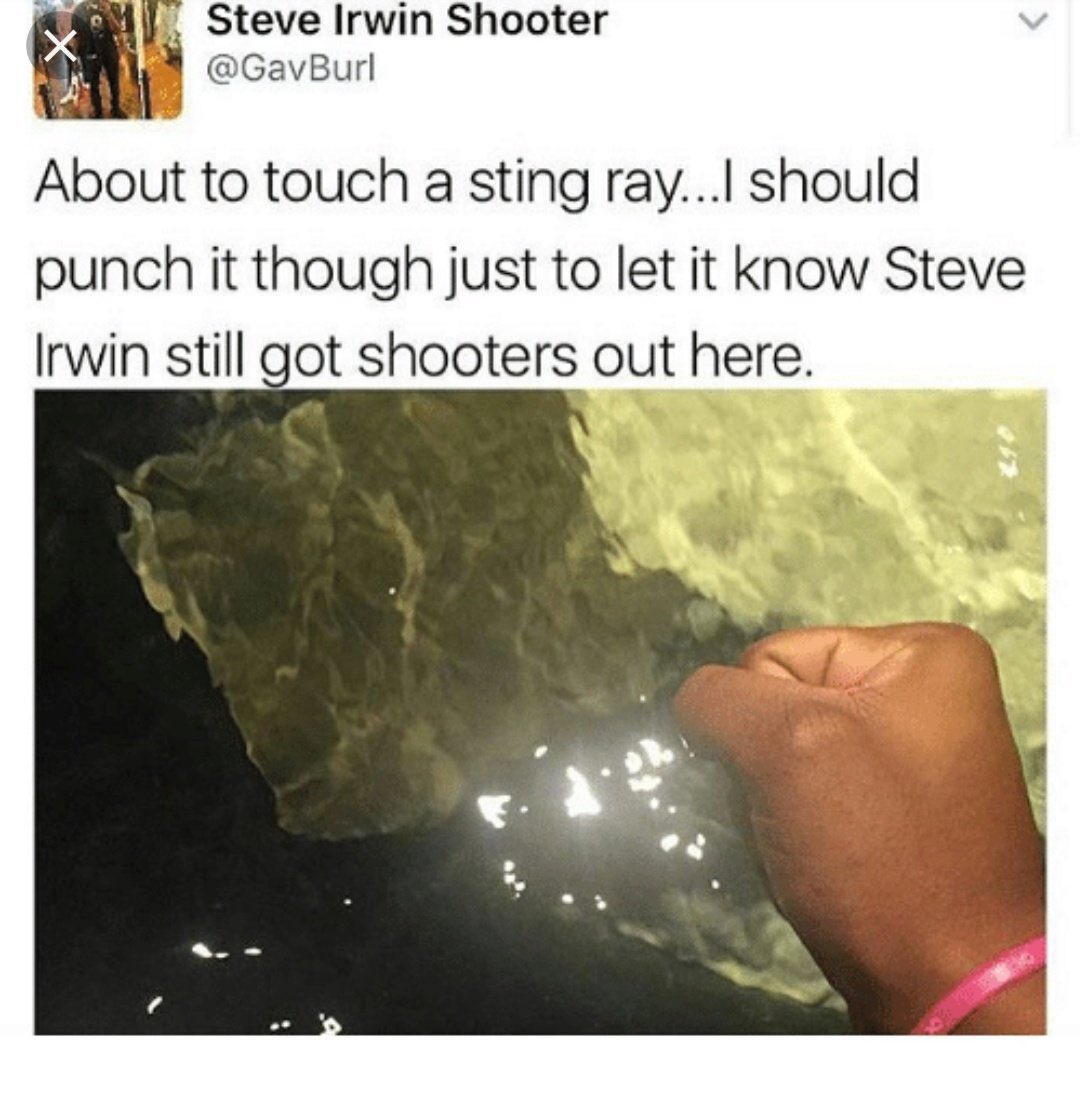
To avoid a stingray sting, shuffle your feet in the sand as you wade through shallow water. This will give stingrays a warning that you’re coming their way. Another option is to throw shells or small rocks into the water ahead of you as you wade.
If you do seek emergency medical care, your healthcare providers will closely inspect your wound. They will need to remove any debris left in the wound from the spines or the sheath.
They may take X-rays of the sting site to determine whether all the debris has been cleared. Spine and sheath fragments are visible on an X-ray.
You might receive an antibiotic via prescription or IV, as well as stitches if the wound is large or deep. You may also receive a tetanus booster.
In some cases, you might require surgery after a stingray sting to remove dead tissue or to repair a severe wound.
For most people, stingray stings heal within a few weeks. Expect localized numbness and tingling around the wound site during the healing period.
Location of the sting, amount of venom in the tissue, extent of tissue damage, and promptness of treatment will affect healing time. If you have to undergo surgery after the sting, your recovery will take more time.
What to do if you get bitten by a stingray
Contents
- How to protect yourself from contact with a stingray
- What are the consequences of a stingray
- What should not be done if a stingray is stung
- What measures can be taken if a stingray is stung
- Interesting facts about rays Stingrays
Stingrays are a family of cartilaginous fish that belongs to the order Stingrays. They live in almost all seas and oceans. They feel great in a very wide temperature range, ranging from 1.5 ° C to 30 ° C. Some species are common in shallow water, others are found at depths up to 2500 meters. There are even stingrays that prefer to live in fresh water.
Stingray
Stingrays have a well-defined tail, which looks like a whip. Its length in some species exceeds half the total length of the fish. The tail ends with one or two serrated spikes, along which furrows with poisonous glands often run. The length of the spike can reach up to 37 cm. Thanks to the powerful muscles of the tail and the exceptionally hard spikes, the stingray can easily pierce a wetsuit, a leg, and the bottom of a wooden boat.
Its length in some species exceeds half the total length of the fish. The tail ends with one or two serrated spikes, along which furrows with poisonous glands often run. The length of the spike can reach up to 37 cm. Thanks to the powerful muscles of the tail and the exceptionally hard spikes, the stingray can easily pierce a wetsuit, a leg, and the bottom of a wooden boat.
It is noteworthy that the stingray uses its tail exclusively for self-defense, since its more than modest teeth are completely unable to cope with such protective functions. When danger arises, the stingray stingray makes sharp lunges up and forward with its tail, and the spike pierces the enemy.
How to avoid contact with the stingray
Stingray spike tip
First, in areas where stingrays spread, enter the water gradually, do not sneak, scuff along the bottom with your feet to scare off the hunter, who may burrow into the sand waiting for a suitable lunch. Be especially careful in shallow bays, river mouths, near beaches, that is, in places that stingrays choose for themselves to hunt.
Secondly, swim in special shoes.
Third, do not enter the water at night.
Fourth, be vigilant while diving, do not tease or pester stingrays.
Fifth, when you find a stingray, make some noise, wave your leg several times under water, try to scare it away.
Sixth, carefully butcher the carcass of the stingray when using it for culinary purposes. The poison of even a dead stingray continues to pose a danger to humans.
What are the consequences of a stingray
Stingray venom has a neurotropic effect, causes instant burning and throbbing pain in the damaged area, the peak of which is observed after 1-1.5 hours. Painful sensations can persist for several days, gradually fading over the next 6-48 hours. They are so pronounced that the victims begin to scream, rush about. In such cases, even loss of consciousness is possible.
Contact with a stingray, in addition to pain, is also accompanied by the following symptoms:
- pallor and subsequent redness or blueness of the skin around the wound,
- nausea,
- dizziness,
- chills,
- drop in blood pressure,
- sudden increase in heart rate,
- the appearance of a feeling of anxiety.

Skate in the water
Less commonly, lymph nodes may swell, sweating may increase, pain in the groin and armpits, vomiting and diarrhea may occur. In severe cases, there is a high probability of convulsions, respiratory failure, the victim may become delirious, lose consciousness.
The greatest danger is represented by large individuals, which have a large amount of poison and a powerful thorn. The lethal outcome is observed mainly when injured in the chest or abdomen.
Plus, the stingray’s barb usually causes a laceration that bleeds profusely. Fragments of its coating can remain in the wound, thereby increasing the risk of infection. In this case, the color of the edges of the wound often changes, tissues are destroyed, and pronounced edema appears.
What not to do when stinging a stingray
Under no circumstances should you jerk out fragments of a spike stuck in a wound. If removed incorrectly, the teeth on the spike can cause additional injury to the victim.
Do not cut the wounds either. Such actions do not ensure the removal of poison, but only unnecessarily injure the victim.
It is not recommended to cauterize the damaged area, as this is fraught with the same unfortunate consequences that were discussed in the previous paragraphs.
Do not inject a solution of potassium permanganate or any other strong oxidizers into the wound.
It is forbidden to drink alcoholic beverages, which only aggravate the situation, accelerating the spread and absorption of the poison.
What measures can be taken in case of a stingray
While waiting for a doctor or on the way to the nearest medical facility, the victim can and should be given first aid.
1. First of all, suck out the poison from small puncture wounds for the first 10 minutes after the injection, spitting it out periodically. This can be done only in the absence of any damage in the oral cavity of the sucker. At the end of the procedure, the mouth must be rinsed with a solution of potassium permanganate or simply clean water.
2. To reduce the concentration of poison and relieve pain, the wound should also be washed with sea water in large quantities.
3. Then carefully remove the remaining pieces of the stud that point backwards. In this case, they should be fed a little forward and slightly rotated to unhook the prong from the fabric, and only then removed.
4. Hot baths are recommended. First, you should apply a pressure bandage above the wound and lower the pricked limb for 30-60 minutes in hot water, the temperature of which is slightly below the burn threshold. 3% magnesium sulfate can be added to the water. Every 10 minutes, the pressure bandage should be loosened and tightened again.
5. Finally, apply an antiseptic dressing and immobilize the limb.
Interesting Stingray Facts
- On the coast of North America, about 750 people suffer from stingrays every year.
- Death is recorded in 1% of cases of contact with stingrays.
- Contact with a stingray proved fatal to popular Australian naturalist and broadcaster Steve Irwin.

- Indians, Malays, Aborigines of Australia and the inhabitants of the islands of the Pacific and Indian Oceans used stingray spikes as points for their spears and arrows. And since a stingray can grow a new thorn several times in its life, the natives even cultivated stingrays.
- Pliny the Elder in his “Natural History” compared the spike of a stingray with a formidable weapon that can kill a tree and pierce armor.
Consequences of a venomous stingray sting
Southern stingray spines (Dasyatis americana)
Rays form one of the largest and most important groups of venomous marine animals. 2,000 stingray stings are reported annually in the US. They live in warm, subtropical and tropical waters. The favorite habitat of these passive, secretive animals is the sandy or muddy bottom of closed lagoons and estuaries, where they feed on crustaceans and molluscs.
Rays have one to four venomous stings on the back of an elongated whip-like appendage. This tail is a cartilaginous process studded with serrated spines. It is covered with a thin layer of skin that hides two ventrolateral areas with venom glands. When the tail plunges into the prey, the epithelial lining of the glands ruptures, releasing the venom. Like other venomous fish, the shell breaks on contact with prey, allowing the venom to enter the wound. The venom contains at least 10 amino acids and toxic substances, including phosphodiesterases, 5′-nucleotidase and serotonin. When extracted, the poison is very quickly destroyed, as it is very unstable and thermolabile.
This tail is a cartilaginous process studded with serrated spines. It is covered with a thin layer of skin that hides two ventrolateral areas with venom glands. When the tail plunges into the prey, the epithelial lining of the glands ruptures, releasing the venom. Like other venomous fish, the shell breaks on contact with prey, allowing the venom to enter the wound. The venom contains at least 10 amino acids and toxic substances, including phosphodiesterases, 5′-nucleotidase and serotonin. When extracted, the poison is very quickly destroyed, as it is very unstable and thermolabile.
Rays only attack defensively, and this usually happens when humans inadvertently touch or step on an animal. If you touch the wings of a stingray, then it throws its tail forward, plunging it into the victim. Out of the water, a stingray can also prick a person while in a net or on a hook. There has been a documented case of injury by a person stepping on a dead, decaying animal.
Rays occasionally appear on the coast of Wales.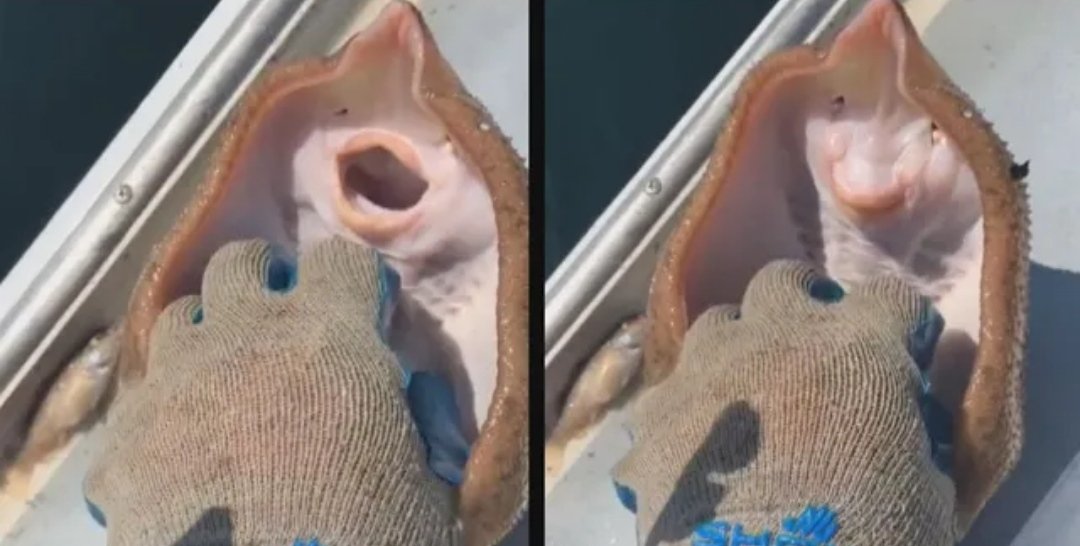 Below is a case of a fisherman getting a lacerated wound on his lower leg from contact with a stingray.
Below is a case of a fisherman getting a lacerated wound on his lower leg from contact with a stingray.
Case description
Stingrays appeared on the coast of Wales in July 1994. An angler caught a 19 kilogram (42 lb) stingray in south Wales but was able to avoid contact with the venomous stinger. On the west coast of Wales, a fisherman caught an 18-kilogram (40 lb) stingray during a fishing event run by the Welsh Fire Department. Several colleagues helped him get the animal to shore, and, unfortunately, one of them hit the stingray, which stuck its tail into the fisherman. The sting penetrated boots (modified rubber) and trousers, tearing the shin of the left leg. The patient reported acute pain in the area of the wound. Later the pain spread to the ankle. The fisherman went to the nearest emergency room. The doctor who examined him reported the incident to the Welsh National Poisons Unit, who gave advice on how to treat the injury. The wound was washed with warm water to neutralize thermolabile poisons. Then it was disinfected, and the edges of the wound were treated surgically under general anesthesia. The wound was not sutured, but bandaged, and the patient was left overnight for further observation. The patient was prescribed antibiotics, tetanus toxoid vaccine was not required. The angler was discharged the next morning and was seen by his therapist. Follow-up showed that the patient went to the emergency room again because the leg was swollen and red. The soft tissues of the leg were examined several times, and the wound healed in two months. There was an 8 cm scar on the lower leg.
Then it was disinfected, and the edges of the wound were treated surgically under general anesthesia. The wound was not sutured, but bandaged, and the patient was left overnight for further observation. The patient was prescribed antibiotics, tetanus toxoid vaccine was not required. The angler was discharged the next morning and was seen by his therapist. Follow-up showed that the patient went to the emergency room again because the leg was swollen and red. The soft tissues of the leg were examined several times, and the wound healed in two months. There was an 8 cm scar on the lower leg.
Discussion
Clinical manifestation
The symptoms of the injection appear immediately. Severe pain appears in the area of the wound, proportional to the severity of the injury. Swelling around the wound is constant, but its severity may vary. The wound turns blue, then erythema (violent reddening of the skin caused by capillary dilation) and petechiae (tiny hemorrhages) may appear. As a result, local tissue necrosis, ulceration, gangrene may occur. Pain peaks within 90 minutes. Without medical treatment of the wound, the pain lasts up to 48 hours. Systemic manifestations and signs can vary greatly and include nausea and vomiting, muscle cramps and fasciculations, sweating, fainting, and headaches. Cardiac arrhythmias, hypotension, convulsions and, in rare cases, death have also been reported.
As a result, local tissue necrosis, ulceration, gangrene may occur. Pain peaks within 90 minutes. Without medical treatment of the wound, the pain lasts up to 48 hours. Systemic manifestations and signs can vary greatly and include nausea and vomiting, muscle cramps and fasciculations, sweating, fainting, and headaches. Cardiac arrhythmias, hypotension, convulsions and, in rare cases, death have also been reported.
Soft tissue injury from a stingray sting can be quite extensive. In addition to the stab wound, the cutting action of the spikes leads to damage and rupture of the underlying soft tissues. Most often, people injure the lower and upper limbs. Serious injuries and deaths from stings from rays are described in Cooper’s article, including fatal cases from tail strikes to the chest and abdomen. Foreign components (cartilage and epithelium) can get into the wound. Secondary infection is quite common due to the unique environment created by seawater. Pathogenic marine bacteria can be halophilic (bacteria that live in environments with high salt concentrations), heterotrophic (bacteria that need complex compounds for nutrition, since the possibilities for their synthesis are limited), motile, gram-negative. The genus of bacteria Vibrio (Vibrio) is quite common and can be very dangerous for people with weakened immune systems.
The genus of bacteria Vibrio (Vibrio) is quite common and can be very dangerous for people with weakened immune systems.
Treatment
The goal of treatment is to neutralize the local and systemic effects of the poison, reduce pain and prevent infection. The wound should be treated immediately with any available liquid. In practice, as a rule, this is sea water. Any noticeable pieces of stinger or epithelial tissue should be removed. As soon as possible, the wound should be washed with warm water (about 40 ° C) for 30-90 minutes, avoiding possible thermal damage. Heat will inactivate any thermolabile poisons. If the pain persists, it can be relieved by lavage with warm water, regional anesthesia, or wound infiltration. Vesicular fluid should be removed in a timely manner under sterile conditions. Then the wound is washed again, examined, necrotic tissues and foreign bodies are removed. With the help of X-rays, the remains of radiopaque cartilage spikes can be determined.

